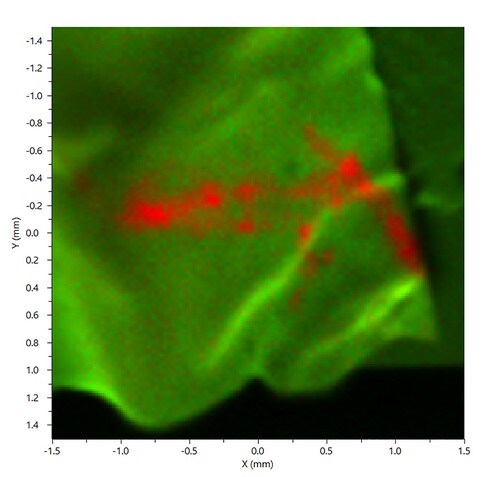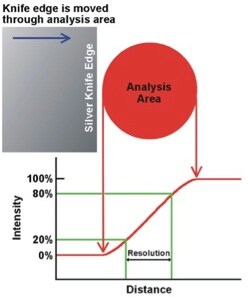Search

Materials Science
High XPS Lateral Resolution for Small Area Analysis
Measurement and analysis of small areas using X-ray photoelectron spectroscopy.
X-ray photoelectron spectroscopy of small areas
Small-area or selected-area X-ray photoelectron spectroscopy (SAXPS) is used to analyze small features on a solid surface, such as a surface blemish or particle. SAXPS maximizes the detected signal coming from a specific area and minimizes the signal from the surrounding area. There are two methods for achieving effective SAXPS. One method uses the spectrometer's transfer lens (i.e., lens-defined SAXPS) to flood the area with X-rays but limit the area from which the photoelectrons are collected. Alternatively, a monochromated beam of X-rays is focused (i.e., source-defined SAXPS) into a small spot on the sample.
Source-defined SAXPS on the ESCALAB Xi+ is used in the range from 900 μm to 200 μm. Below 200 μm, lens-defined SAXPS is used, which can extend the lateral resolution for spectroscopy to <20 μm. On the Nexsa, a source defined analysis area is from 400 µm to 10 µm, and on the K-Alpha from 400 µm to 50 µm. On both Nexsa and K-Alpha small features can easily be found using the XPS-SnapMap capability.
The irises used for lens-defined SAXPS on the ESCALAB Xi+ are motor-driven and computer-controlled, which enables maximum repeatability and remote control. The advantage of using irises rather than apertures is that any analysis area can be chosen within the permitted range. The analysis area, therefore, can be closely matched to the size of the feature being analyzed, maximizing the signal. Small-area spectra with a lateral resolution < 20 μm can be obtained by deriving spectra from a stack of parallel images
XPS lateral resolution
To estimate the lateral resolution in SAXPS, a knife-edge sample (often silver) is translated through the analysis area while measuring the XPS signal (e.g., the signal from the Ag 3d5/3 peak). The signal is initially zero until the knife-edge intercepts the analysis area. The signal intensity increases until the silver fills the entire analysis area. This method is effective assuming that the analysis area is circular, there is no transmission outside this area, and transmission is uniform within the area (i.e., the transmission as a function of position on the sample resembles a 'top hat' distribution).
The signal is then plotted against distance. The distance through which the knife-edge has to be translated for the signal to change between two prescribed percentages of the total signal change is then determined. This distance is described as the lateral resolution for spectroscopy. The percentages used depend upon the instrument manufacturer. Thermo Scientific Instruments use the range 20% to 80% because the reported spatial resolution is approximately equal to the radius of the analysis area (within <2%). If the response of the spectrometer can be accurately represented by a Gaussian curve instead of a top hat, then a value of 16% to 84% represents the distance between the two points each one standard deviation on either side of the center of the analysis area.
The method described above is specifically for when the analysis area is defined by the transfer lens ahead of the analyzer (lens-defined SAXPS). The same method can be used when the area is defined by the X-ray spot size (source-defined SAXPS).




